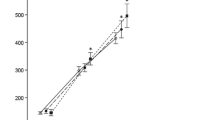Abstract
Two methods of heparin monitoring, semi-automated in-vivo heparin protamine titration (HPT) and activated clotting time (ACT), were compared in each of sixteen adult patients undergoing extracorporeal circulation (ECC) for coronary artery bypass surgery. The HPT method determined the initial and maintenance level of heparin for ECC, as well as, the amount of protamine needed for neutralization of heparin. ACT determinations were made in parallel to calculate heparin levels, heparin sensitivity, and protamine requirements. ACT determinations increased from 502±31 seconds after heparinization to 739±49 seconds (p<0.05) five minutes after the start of ECC. The HPT method determined heparin sensitivity to be 153±17 secs/mg/kg and this did not change after the institution of ECC. The increase in ACT observed after the start of ECC resulted in an increase in heparin sensitivity from 151±13 secs/mg/kg initially, to 247±17 secs/mg/kg after the institution of ECC (p<0.01). During ECC, the HPT method reported heparin levels which remained near the initial value of 2.40±0.12 mg/kg. The ACT method's initial heparin level of 2.66±0.12 mg/kg rose after the start of ECC to 4.39±0.55 mg/kg (p<0.05). The HPT method adequately predicted protamine requirements, 2.66±0.15 mg/kg protamine vs. 3.47±0.14 mg/kg actual dose while the ACT method predicted excess: 5.02±0.34 mg/kg (p<0.01). In-vivo heparin-protamine titration method provided more consistent information during ECC and directed a significantly smaller dose of protamine for heparin neutralization.
Similar content being viewed by others
References
Allen TH. Prediction of blood volume and adiposity in man from body weight and cube of height. Metabolism 1956; 5: 32–345.
Arkin CF, Shahsavari M, Copeland BE, Kim A. Evaluation of the activated clotting time to control heparin and protamine dosage in open-heart surgery. J Thorac Cardiovasc Surg 1978; 75: 790–91.
Bull BS, Korpman RA, Huse WM, Briggs BD. Heparin therapy during extracorporeal circulation — I. Problems inherent in existing heparin protocols. J Thorac Cardiovasc Surg 1975; 69: 674–84.
Bull MH, Huse WM, Bull BS. Evaluation of a test used to monitor heparin therapy during extracorporeal circulation. Anaesthesia 1975; 43: 346–53.
Culliford AT, Geitel SN, Starr N, Thomas ST, Baumann FG, Wessler S, Spencer FC. Lack of correlation between activated clotting time and plasma heparin during cardiopulmonary bypass. Ann Surg 1981; 193: 105–11.
Day TK. Pure anti-heparin component of protamine. Lancet 1979; 2: 1027.
Ellison N, Ominsky AJ, Wollman H. Is protamine a clinically important anticoagulant? Anesthesiology 1971; 35: 621–9.
Guffin AV, Dunbar RW, Kaplan JA, Bland JW. Successful use of a reduced dose of protamine after cardiopulmonary bypass. Anesth Analg 1976; 55: 110–13.
Hattersley PG. Activated coagulation time of whole blood. JAMA 1966; 196: 436–40.
Jacques LB. Protamine — antagonist to heparin. Can Med Assoc J 1973; 108: 1291–7.
Jobes DR, Schwartz AJ, Ellison N, Andrews A, Ruffini RA, Ruffini JJ. Monitoring heparin anticoagulation and its neutralization. Ann Thorac Surg 1981; 31: 161–6.
Kaul TK, Crow MJ, Rajah SM, Deverall PB, Watson DA. Heparin administration during extracorporeal circulation. J Thorac Cardiovasc Surg 1979; 78: 25–102.
Pifarré R, Babka R, Sullivan HJ, Montoya A, Bakhos M, El-Etr A. Management of postoperative heparin rebound following cardiopulmonary bypass. J Thorac Cardiovasc Surg 1981; 81: 378–81.
Umlas J, Taff RH, Gauvin G, Swierk P. Anticoagulant monitoring and neutralization during open heart surgery—a rapid method for measuring heparin and calculating safe reduced protamine doses. Anesth Analg 1983; 62: 1095–9.
Umlas J, Gauvin G, Taff RH. Heparin monitoring and neutralization during cardiopulmonary bypass using a rapid plasma separator and a fluorometric assay. Ann Thorac Surg 1984; 37: 301–3.
Author information
Authors and Affiliations
Rights and permissions
About this article
Cite this article
Stead, S.W. Comparison of two methods for heparin monitoring: A semi-automated heparin monitoring device and activated clotting time during extracorporeal circulation. J Clin Monit Comput 6, 247–254 (1989). https://doi.org/10.1007/BF01733630
Accepted:
Issue Date:
DOI: https://doi.org/10.1007/BF01733630




